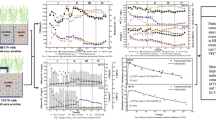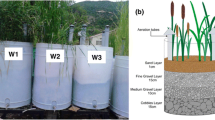Abstract
Constructed wetlands are recognized as a reliable technology for rural wastewater treatment. However, conventional constructed wetlands face problems with low pollutant removal efficiency and limited oxygen transfer capability. Therefore, a novel vertical flow constructed wetland (VFCW) system with drop aeration was developed in this study. Two pilot-scale vertical flow constructed wetlands of 0.75 m2 each were constructed with the same dimensions and configuration but different media, one of which (named as CW1) was filled with a 1:1 mixture (by weight) of zeolite and dolomite and the other (named as CW2) with the same zeolite only. The oxygen transfer capability of a multilevel two-layer drop aeration device, organics and nitrogen removal of CW1 and CW2, and pollutant distribution along the depths of CW1 and CW2 in different operational phases were studied. The results demonstrated that compared with the direct drop aeration process, the multilevel, two-layer drop aeration device supplied 2–6 mg/L higher dissolved oxygen per meter of drop height, and after installation of the six-level, two-layer drop aeration devices, the 5-day biochemical oxygen demand removal load was improved from 8.1 to 14.2 g m−2 day−1 for CW1. With regard to the different filter media, nitrogen removal was improved by the adsorption of zeolite in the first year, with 5–36% higher NH +4 –N removal efficiency of CW2 compared with that in CW1. Since it did not have a significant positive effect on phosphate removal, dolomite can be replaced by zeolite. The chemical oxygen demand removal mainly took place in the upper 15-cm filter layer in different operational phases, while nitrogen distribution along the depths of the VFCWs was different in different operational phases. In addition, as no operational problems occurred, the vertical flow constructed wetland system with drop aeration is an appropriate alternative for rural wastewater treatment, with numerous advantages of low capital and operation costs, no energy consumption, easy maintenance, high hydraulic loading rate, high pollutant removal efficiency, and no clogging.











Similar content being viewed by others
References
Arroyo, P., Ansola, G., & Luis, E. (2010). Effectiveness of a full-scale constructed wetland for the removal of metals from domestic wastewater. Water, Air, and Soil Pollution, 210, 473–481.
Austin, D. C., Lohan, E., & Verson, E. (2003). Proceedings of the Water Environment Technical Conference 2003, Los Angeles, California.
Babatunde, A. O., Zhao, Y. Q., O’neill, M., & O’sullivan, B. (2008). Constructed wetlands for environmental pollution control: A review of developments, research and practice in Ireland. Environment International, 34(1), 116–126.
Bao, S. (2000). Chemical analysis for agricultural soil (2nd ed.). Beijing: China Agriculture Press.
Behrends, L., Sikora, F., Coonrod, H., Bailey, E., & Bulls, M. (1996). Proceedings of WEFTEC '96; The 69th Annual Conference and Exposition of the Water Environment Federation, Alexandria, Virginia.
Brix, H., & Arias, C. A. (2005). The use of vertical flow constructed wetlands for on-site treatment of domestic wastewater: New Danish guidelines. Ecological Engineering, 25(5), 491–500.
Cameron, K., Madramootoo, C., Crolla, A., & Kinsley, C. (2003). Pollutant removal from municipal sewage lagoon effluents with a free-surface wetland. Water Research, 37(12), 2803–2812.
CEPB (China Environmental Protection Bureau). (2004). Standard methods for examination of water and wastewater (4th ed.). China: Chinese Environmental Science Press.
Coleman, J., Hench, K., Garbutt, K., Sexstone, A., Bissonnette, G., & Skousen, J. (2001). Treatment of domestic wastewater by three plant species in constructed wetlands. Water, Air, and Soil Pollution, 128, 283–295.
Cooper, P. (2009). What can we learn from old wetlands? Lessons that have been learned and some that may have been forgotten over the past 20 years. Desalination, 246(1–3), 11–26.
Dufay, J. A. (2000). Constructed wetlands remediation system. New Mexico Patent 6,159,371.
Flowers, D. A. (2002). Process and system for enhanced nitrogen removal in a wetland wastewater treatment facility. United States Patent 6,447,682.
Green, M., Friedler, E., & Safrai, I. (1998). Enhancing nitrification in vertical flow constructed wetland utilizing a passive air pump. Water Research, 32(12), 3513–3520.
Herrera Melián, J. A., Martín Rodríguez, A. J., Arana, J., González Díaz, O., & González Henríquez, J. J. (2010). Hybrid constructed wetlands for wastewater treatment and reuse in the Canary Islands. Ecological Engineering, 36(7), 891–899.
Hua, G. F., Zhu, W., Zhao, L. F., & Huang, J. Y. (2010). Clogging pattern in vertical-flow constructed wetlands: Insight from a laboratory study. Journal of Hazardous Materials, 180(1–3), 668–674.
Joan, G., Rousseau, D., Caselles, O. A., Story, A., Pauw, N., & Vanrolleghem, P. (2007). Impact of prior physico-chemical treatment on the clogging process of subsurface flow constructed wetlands: Model-based evaluation. Water, Air, and Soil Pollution, 185, 101–109.
Li, J., Zhong, C., & Deng, C. (2008). Study on relationship among waterfall aeration height, flux and reoxygenation content. Environmental Science (China), 34(5), 39–41.
Liang, H., Gao, M., Liu, J., Wei, Y., & Guo, X. (2010). A novel integrated step-feed biofilm process for the treatment of decentralized domestic wastewater in rural areas of China. Journal of Environmental Sciences, 22(3), 321–327.
Liu, J., Zou, J., & Guo, X. (2010). Multi-level two-layer returning water-spreading drop oxygenating method and device. State Intellectual Property Office of the P. R. C. Patent 200910244241.
Luederitz, V., Eckert, E., Lange-Weber, M., Lange, A., & Gersberg, R. M. (2001). Nutrient removal efficiency and resource economics of vertical flow and horizontal flow constructed wetlands. Ecological Engineering, 18(2), 157–171.
Martin, I., Betancort, J. R., & Pidre, J. R. (2007). Contribution of non-conventional technologies for sewage treatment to improve the quality of bathing waters (ICREW project). Desalination, 215(1–3), 82–89.
MHURDPRC. (2005). Present situation and problems of rural human settlements. Beijing: Ministry of Housing and Urban-Rural Development of the People's Republic of China.
Prochaska, C. A., Zouboulis, A. I., & Eskridge, K. M. (2007). Performance of pilot-scale vertical-flow constructed wetlands, as affected by season, substrate, hydraulic load and frequency of application of simulated urban sewage. Ecological Engineering, 31(1), 57–66.
Steer, D., Fraser, L., Boddy, J., & Seibert, B. (2002). Efficiency of small constructed wetlands for subsurface treatment of single-family domestic effluent. Ecological Engineering, 18(4), 429–440.
Tanner, C. C. (2001). Plants as ecosystem engineers in subsurface flow treatment wetlands. Water Science and Technology, 44, 9–17.
Tietz, A., Kirschner, A., Langergraber, G., Sleytr, K., & Haberl, R. (2007). Characterisation of microbial biocoenosis in vertical subsurface flow constructed wetlands. Science of the Total Environment, 380(1–3), 163–172.
Wallace, S. D., Parkin, G. F., & Cross, C. S. (2001). Cold climate wetlands: Design and performance. Water Science and Technology, 44(11/12), 259–266.
Wang, Y. F., Lin, F., & Pang, W. Q. (2007). Ammonium exchange in aqueous solution using Chinese natural clinoptilolite and modified zeolite. Journal of Hazardous Materials, 142(1–2), 160–164.
Zhang, L., Zhang, L., Liu, Y., Shen, Y., Liu, H., & Xiong, Y. (2010). Effect of limited artificial aeration on constructed wetland treatment of domestic wastewater. Desalination, 250(3), 915–920.
Zhao, L., Zhu, W., & Tong, W. (2009). Clogging processes caused by biofilm growth and organic particle accumulation in lab-scale vertical flow constructed wetlands. Journal of Environmental Sciences, 21(6), 750–757.
Zheng, J. (2006). Study on upland constructed wetland. Chongqing: Chongqing University.
Zhou, Q., He, F., Zhang, L., Wang, Y., & Wu, Z. (2009). Characteristics of the microbial communities in the integrated vertical-flow constructed wetlands. Journal of Environmental Sciences, 21(9), 1261–1267.
Acknowledgments
This work was supported by Major Science and Technology Program for Water Pollution Control and Treatment (2008ZX07101-006-3) and Knowledge Innovation Project of Chinese Academy of Sciences of young talents (no. RCEES-QN-2007xx).
Author information
Authors and Affiliations
Corresponding author
Rights and permissions
About this article
Cite this article
Zou, J., Guo, X., Han, Y. et al. Study of a Novel Vertical Flow Constructed Wetland System with Drop Aeration for Rural Wastewater Treatment. Water Air Soil Pollut 223, 889–900 (2012). https://doi.org/10.1007/s11270-011-0910-x
Received:
Accepted:
Published:
Issue Date:
DOI: https://doi.org/10.1007/s11270-011-0910-x




